Can I Tour FBI Headquarters in Washington, DC?
Yes, you can tour the fbi education center, but visits require up to a month of advanced notice..
Seeing the J. Edgar Hoover Building, or FBI HQ (as some in the know might call it), is a pretty great way to experience the increasingly important work the FBI does to protect this city – and this country.
You must arrange your visit through your Congressional office. Visit this website to find out the name and contact information for your Congressional representative. The FBI requires up to a month for advance notice from Congressional offices prior to your visit; this is because the FBI will perform a security check on all visitors. The visit itself will take about two hours.
The FBI Headquarters is located between 9th and 10th Streets NW. The closest Metro subway stops are Federal Triangle on the Orange, Blue and Silver lines, Gallery Place/Chinatown and Metro Center on the Red Line, and Archives/Navy Memorial on the Yellow and Green lines.
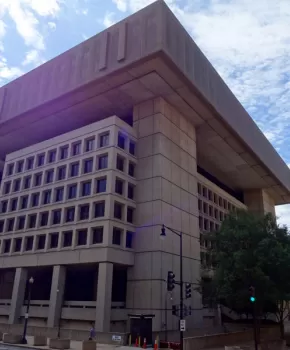
Matt C via Flickr
More on the FBI Building and Tour
The tour of the FBI is actually one of the oldest ones around. It started in 1937, when headquarters was in the Department of Justice building. In 1975, the FBI moved to its current location, the J. Edgar Hoover Building, on Pennsylvania Avenue NW.
After Sept. 11, the tour closed for security reasons. Never fear, sleuths of all ages. It’s now back open and, we’d say, better than ever. The tour was modernized and updated in 2008, as the FBI created a full-fledged Education Center to assist in teaching the public the importance and central role of the FBI in law enforcement and national security.
But what does the FBI actually do?
Surely, you’ll learn just a bit more about that on the tour, but we can clue you in on a couple things. The FBI’s mission is to protect the United States from internal and external threats, whether clear and imminently dangerous, or more metaphysical and long-term, all with the goal of improving the security of our nation. The FBI has grown and changed since its inception, now incorporating both intelligence and law enforcement in its mandate. That means it works to uphold local and national laws, but also investigate those hard-to-define threats. And, OK, since you probably aren’t a special agent, we can tell you some of the things these important people, stationed all over the world, look into: domestic and international terrorism, counterintelligence, cyberwarfare, corruption, civil rights, organized crime (the “mob”), white-collar crime and more.
There are so many great tours and sightseeing opportunities in Washington, DC. Discover your next tour adventure .
More About DC

You may also like..
Which Attractions & Museums in Washington, DC Require Tickets?
11 Things to See & Do in Penn Quarter & Chinatown
How Can I Tour the Monuments & Memorials in Washington, DC?
This website uses cookies to improve your browsing experience and analyze the use of the website. Learn More
Reserve Your Spot with Confidence! Full Refunds with 24 Hrs Notice. Reschedule at any point, even after tour, if space allows!

Tour the FBI Building in Washington DC

This post is about how to visit and take a tour of the FBI Experience at the FBI Headquarters in Washington, DC.
We include tips on how to plan your visit, and what you will see.
- How to Book a Tour
- Getting Here
- FBI Experience Museum
- About the Building
- Things to Do in DC

Can I Tour the FBI Building Headquarters?
The FBI building is technically closed to the public. However, with advance planning and help from your Congressperson, you can still tour the FBI Education Center.
Originally created as a way to introduce new employees and other government officials to the workings of the FBI, in 2014, it was opened to the public.
Like arranging a visit to the White House , you must go through your Congressperson. The tours can be scheduled for business days 9 am - 3 pm. The building is closed on federal holidays.
(You can find out who you Member of Congress is here ).
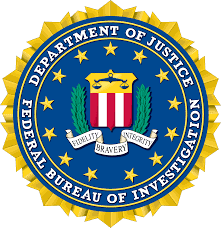
This must be done no less than four weeks in advance. All applicants for a tour of the FBI Education Center will be vetted and subject to a background check. You will need to provide your:
- date of birth
- social security number
For groups of 20 or more, you can submit a request directly here. Don't try to request a tour with this link if you have less than 20 people, as it will be ignored.
FBI Tours are open to US citizens and green card holders only.
If you are cleared to enter the FBI Building, you will be notified two weeks prior to your confirmed date.
If you are granted a tour, plan on 2 hours for the tour itself and arriving 15 minutes early. The tours operate on weekdays during normal business hours.
SECURITY AT THE FBI HEADQUARTERS
There is no storage at the FBI Headquarters. If you're looking for bag storage before your tour, check out our post on luggage storage in DC .
The following items are strictly prohibited and may not be brought into FBI Headquarters:
- Backpacks, diaper bags, fanny packs, briefcases, luggage, computer and camera bags, or bags and purses larger than a clutch
- Point-and-shoot cameras, SLR cameras, or video recorders; cell phone cameras are permitted but must be on airplane mode during the visit.
- Food, beverages, tobacco products, personal grooming items (e.g. makeup, lotion, etc.)
- Any pointed objects
- Aerosol containers
- Guns, ammunition, fireworks, electric stun guns, mace, martial arts weapons/devices, or any knives.
Can you take photos on the FBI Tour?
Yes! You may take photos inside the FBI Experience exhibit only. You will not be able to take photographs at all in the screening process
HOW TO GET HERE
Conveniently located downtown Washington, DC ( map ), it is very easy to get to the FBI Building.
Metro: The FBI Building is about a five-minute walk from four different Metro stations. Read our guide on how to use the DC Metro (subway).
- Federal Triangle: Blue/Orange/Silver
- Archives/Navy Memorial: Yellow/Green
- Chinatown: Red/Yellow/Green
- Metro Center: Blue/Orange/Silver

It is also on Pennsylvania Ave NW, and a direct walk from the White House or the US Capitol Building , an easy walk from the Smithsonian Museums on the National Mall, and you can see it from Ford's Theatre .
Parking: You will find street parking in the area surrounding the FBI Building, just not directly in front of the building. If you need a parking garage, the closest is on 10th St NW between E and F Streets NW, just next to Ford's Theatre.
We recommend booking convenient and affordable parking in advance through SpotHero, the nation’s leading parking reservation app.
To reserve your parking spot, visit the SpotHero Parking Page and book a spot with rates up to 50% off drive-up.
New to SpotHero? Click here to download the SpotHero app.
The FBI Experience Museum

Once through security, an escort takes you to another secure area, across the courtyard (they have workout equipment, an outdoor running track, tables, etc.) and into the FBI Experience Museum.
Your escort gives you an intro but then the museum is self-guided.
Visitor services reps are stationed throughout to answer questions - all are FBI or former FBI agents or employees and are very knowledgeable.
Some of the highlights of the tour are:
In the exhibit on surveillance, find the hidden camera in the painting - it’s the period in the signature!

You can check out the desk of infamous FBI Director J. Edgar Hoover, who the headquarters building is named for.
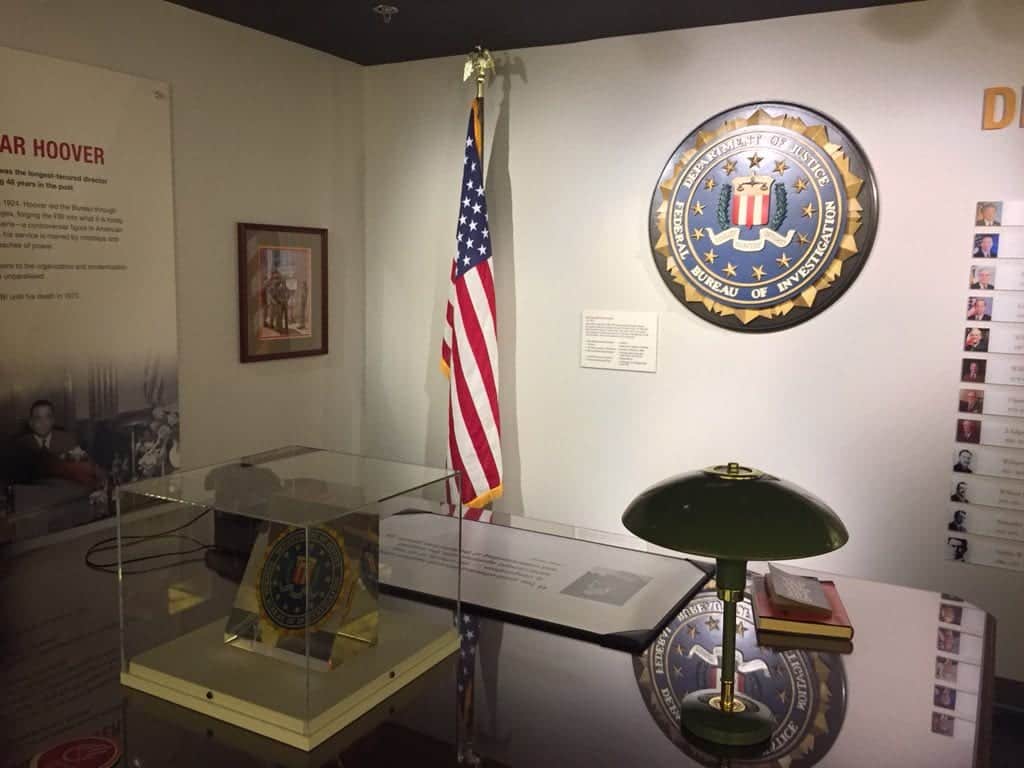
There are also some artifacts on display that take your breath away, like this case with ephemera collected from the World Trade Center on 9/11.
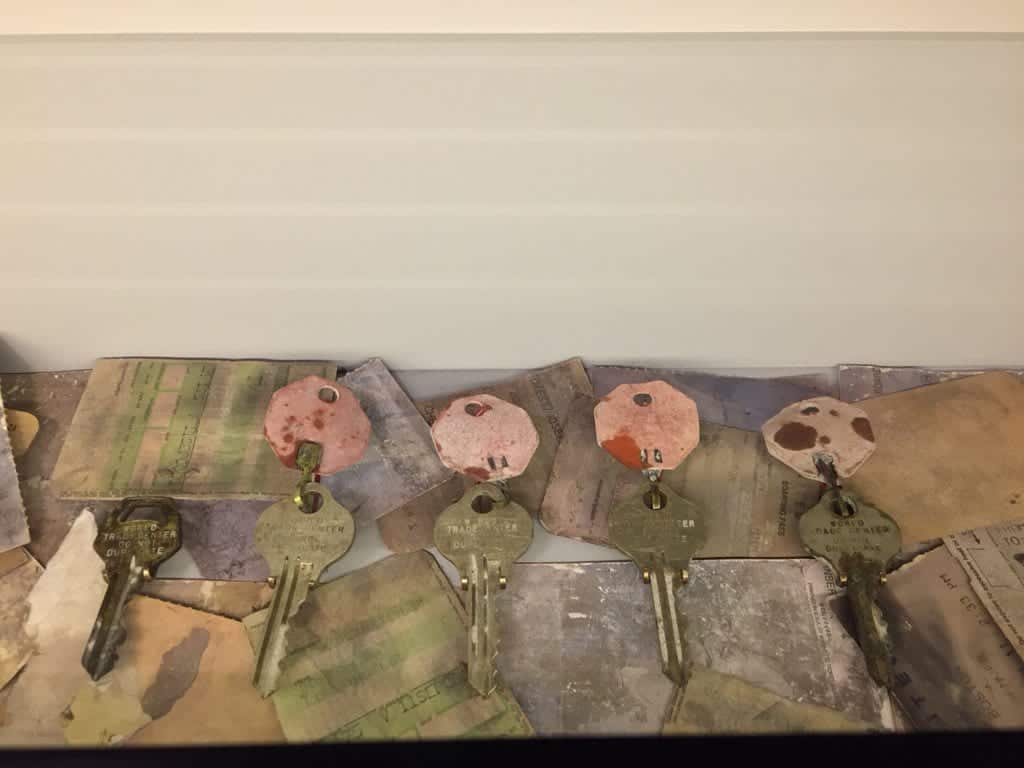
The J. Edgar Hoover FBI Headquarters
The FBI moved into this building in 1975 from the Department of Justice building across the street.
It was immediately criticized and remains unloved by most to this day. In fact, the FBI will be moving soon - the building has reached the end of its lifespan.
It is not yet public knowledge where the FBI Headquarters will relocate or what will happen to this building or plot of land.
The FBI wanted a building that was bomb-proof for the first few levels and had secured access points throughout.
The design firm of Murphy & Associates were hired to design the structure.
The building includes theaters, classrooms, auditoriums and three levels below ground, as well as:
- An automobile repair shop
- A two-story basketball court
- Cryptographic vault
- Developing laboratories for both still photography and motion pictures
- Exercise rooms
- A film library
- A firing range
- 80,000 square feet (7,400 m 2 ) of laboratory space
- A medical clinic
- A printing plant
- A test pattern and ballistics range
Despite its immense size, not all of the FBI's holdings are kept inside the Hoover Building in downtown Washington DC.
The FBI Laboratory is located in Quantico, Virginia at Marine Base Quantico. It is one of the largest crime labs in the world.
FBI Building Flags
As you walk along the Pennsylvania Ave side of the building, you'll notice many American flags along the FBI Building.
Look closely, they are each different. Starting at 10th St NW, you'll notice 10 different flags flanked by our current 50-star flag.

- The Flag of 1777 , which had no official arrangement for the 13 stars. It was flown by John Paul Jones on the USS Ranger and was the first American flag to be recognized by a foreign power.
- The Betsy Ross Flag , 13 stars, designed by George Washington, Betsy Ross, and Francis Hopkinson. Although rarely used, it was adopted by Congress on June 14, 1777--the official date of today's Flag Day.
- The Bennington Flag , 13 six-pointed stars, allegedly flown August 16, 1777, over military stores at the Battle of Bennington, Vermont, when the Vermont militia beat back a superior British force.
- The Star Spangled Banner , 15 stars and 15 stripes, immortalized by Francis Scott Key in our National Anthem during the bombardment of Ft. McHenry, Maryland, in September 13, 1814.
- The Flag of 1818 , 20 stars, commissioned by a Congressional Flag Act that returned the design to 13 stripes and stipulated that stars be added for each new state.
- The Great Star Flag , 20 stars, designed by Captain Samuel Chester Reid, U.S. Navy, at the request of New York Congressman Peter Wendover and flown over the U.S. Capitol on April 13, 1818.
- The Lincoln Flag , 34 stars, raised by President Lincoln on February 22, 1861, over Philadelphia's Independence Hall to send a message to Southern states, which were preparing to secede from the Union.
- The Iwo Jima Flag , 48 stars, which was commissioned in 1912 but came to symbolize our Nation on February 19, 1945, when U.S. Marines raised it on Mount Suribachi after fearful fighting in World War II's Pacific campaign.
- The 49-Star Flag , commissioned in 1959 when Alaska achieved full Statehood. It flew for only one year, until July 4, 1960, after Hawaii achieved its Statehood and when today's 50-star flag became official.
Related Content:
- How to Get Tickets to the Washington Monument
- How to Get Tickets to the Holocaust Museum
- How to Visit the White House on a Public Tour
- Can I tour the Pentagon?
- Free Tours by Foot
Check out our DC Tourism Guide , with budget advice, travel guides, and information about local Washington DC attractions, including Free Things to Do in DC .
Choose a Destination... I want them all PLUS general travel tips. Amsterdam Berlin Boston Charleston Chicago Dubai Lisbon London Los Angeles Miami Nashville New York City New Orleans Paris Philadelphia Prague Rome San Francisco Washington DC
About The Author

Canden Arciniega
North america, united kingdom & ireland, middle east & india, asia & oceania.

Inside Look: Touring the FBI Headquarters in Washington DC
I’ve always been fascinated by the inner workings of the FBI. So when I learned that they offer public tours of the J. Edgar Hoover Building in Washington DC, their headquarters, I knew I had to find a way to visit.
Planning a trip to DC can be a bit of a juggling act. You gotta align your visit with when things will actually be open. So, when I was putting in my White House Ticket request three months in advance and saw that you could tour the FBI too, I jumped.
The tour was on the top of my son’s wish list. When we told him about it, I didn’t want to get his hopes up.
The thing is, you can do everything right, pass a background check, but still not get in. The wait was agonizing, but it ended up being the highlight of the entire trip!

How to get tickets to tour the FBI in Washington DC?
Obtaining tickets for the FBI tour requires careful preparation and perseverance. Unlike most tourist attractions, you can’t simply book online. Instead, you need to request tickets through your state representative’s office.
I contacted my congressman’s office 3 months before my visit. They submitted the request to the FBI, and about 3 weeks later, they called to verify my identity and background information.
After completing a basic background check, it became a waiting day. That’s because they don’t confirm your visit until 1 week beforehand.
My hunch is that they need to keep things flexible in case high profile events are going on. And in the fall of 2023, there are a few.
Arriving at the FBI
When the big day arrived, I made sure to arrive 30 minutes early at the Pennsylvania Ave address. We actually went there 45 minutes early and took a quick side trip to Ford Theatre just a few blocks away.
When it comes to the FBI, they are a very secure locked down building. We showed up to find a few others waiting outside the building and a few others walking out.
They had just been turned away for walking 31 minutes early.
We decided to give it a try right on time and had a little pushback before they realized it was the right time.
We showed them our Drivers Licenses, and they gave us our lanyards and visitors passes. There are no official tickets, just a reservation.
One rule in the FBI is no cameras in the main part of the building. You also have to have your phones in Airplane mode.
I went through a security screening and proceeded down to the waiting area. The tour actually starts in the gift shop where I picked up a few souvenirs. My group and I were then escorted to the engaging FBI Experience. This is where the real fun began!
The FBI Experience covers two floors. The tour starts on the second floor. You’ll be outside in their atrium and climb a flight of stairs. You’ll exit the tour at the back of the building.

Touring the FBI Headquarters in Washington DC
The FBI Experience has a series of exhibits and activities that provides an insider’s view of FBI operations. Now that we were in the experience, we were allowed to take photos and document our visit. Some of the highlights included:
- Shooting range – No photos here, and it was being remolded. But you can see agents in action!
- Bank robbery investigative experience – I had to study the evidence and catch the suspect.
- Computer forensics lab – I analyzed data just like computer forensic teams.
- Hidden camera room – I searched for tiny hidden cameras with my phone flashlight. Found both. There is a video monitor on the other side of the room to help guide you. If you want a hint, make sure to ask an agent.
- Spy equipment from different operations.
- Historical artifacts – I saw the Unabomber’s journal, items from 9/11, John Dillinger’s Tommy gun, and more.
- FBI’s Most Wanted Wall – The infamous top 10 list with photos/descriptions of fugitives.
Throughout the experience, there were FBI agents on hand that provided additional details and answered all of your questions. It was great getting an insider’s view.
The agents were super friendly. I think part of it was in my head, but the agents around the outside of the building were a little more intimidating.
The tour took about 1 hour and 30 minutes total. You don’t have to stay with your group and can take as much time as you need.
Each admission group had around 30 people. If you don’t get a tour, that’s probably why. Unless you were flagged in your background check.
At the end, we all took a fun quiz to find out what FBI job we would be best suited for. I got forensic scientist! The kids are both suited to be Special Agents.
We got to leave with a sevener, our security badges.
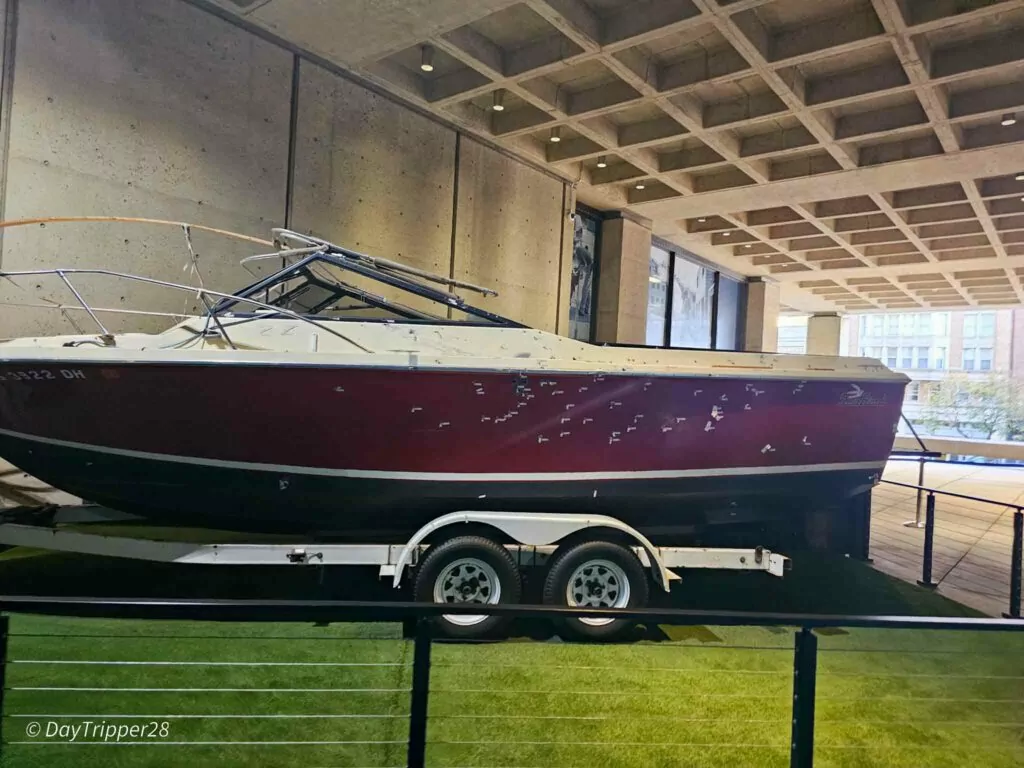
Frequently Asked Questions about FBI Headquarters Tours
How do i get tickets to tour the fbi.
You need to request them through your state representative or congressperson’s office. The FBI does not handle public ticket bookings.
How far in advance should I request tickets to Tour the FBI?
You can request tours up to 5 months in advance and no later than 4 weeks before. Tickets are limited and the background check process takes time. The earlier the better!
What are the hours and days that tours take place?
Tours run Monday through Friday between 9:00 a.m. and 4:30 p.m., excluding federal holidays.
What is the cost?
The tours are free.
What should I bring To the FBI Tour?
Bring yourself, your photo ID, wallet, and your phone. That’s it!
The list of prohibited items includes bags larger than 8 ½” x 11”, cameras (point and shoot, SLR, video records), strollers, food, drinks, tobacco, aerosols, and weapons.
Bring a printed ticket, photo ID, and leave any other personal items (including cell phones and cameras) secured off site.
Would I recommend the FBI Experience Tour in Washington DC?
I highly recommend taking the FBI tour if you ever get the chance. It provides a one-of-a-kind look at the storied history and fascinating operations within the bureau.
Just be prepared for the detailed planning required to secure tickets. The early effort pays off for this rare experience!
If you really love the spy parts of the tour, check out the Spy Museum!
Minnesota native and Midwest travel expert Jennifer provides insider tips and budget-friendly trip ideas for families looking to explore the Land of 10,000 Lakes. Through her travel blog DayTripper28, she draws on first-hand experience to recommend the best hidden gems, outdoor adventures, road trips, and weekend getaways around Minnesota and the Midwest. With her passion for uncovering local flavors and culture along the backroads, Jennifer shares affordable itineraries for creating memorable experiences across the region.
Similar Posts

The BEST Breweries in Duluth MN in 2024
Duluth, Minnesota is home to some of the best breweries in the state. Whether you’re a craft beer enthusiast…
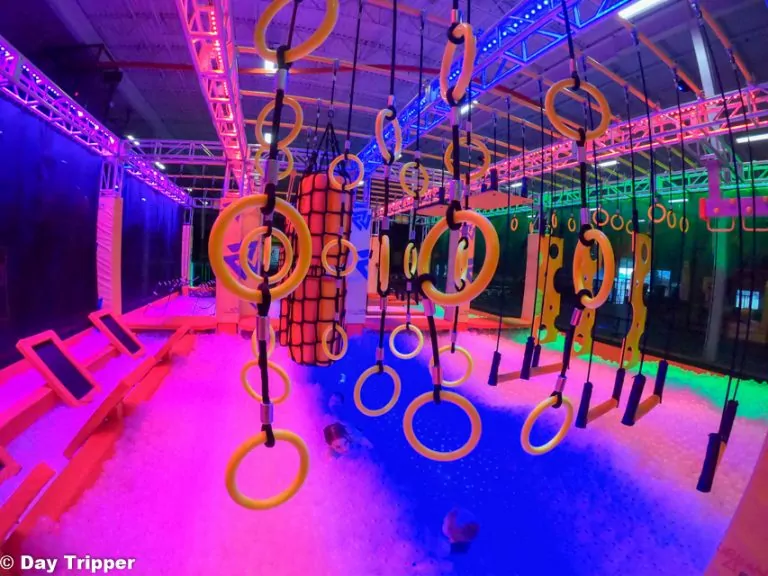
Indoor Fun At Urban Air Adventure Park in Plymouth
Back before Stay at Home issues were orders, life was so much easier. Going out wasn’t a production. Thankfully…
Judy Garland Museum in Grand Rapids Minnesota
Ever since Judy Garland first sand Somewhere Over the Rainbow, she captured people’s hearts. Her voice drew in crowds…

Family Fun at Minnesota’s North Shore Adventure Park in Silver Bay
Looking for something to do along MN’s North Shore that doesn’t include a hiking trail? It seems like anytime…

An Alpine Escape at the Rooftop Nordic Village in Minneapolis
Transport yourself to an oasis without leaving downtown Minneapolis. The place is called the Rooftop Nordic Village atop the…

The World’s Second Longest Granite Wall is in St Cloud MN
Rising from the pine-dotted landscape along Highway 10 near St. Cloud stands an enduring landmark – the towering granite…
FBI Headquarters

- Archives • 4 min walk
- Federal Triangle • 5 min walk

Most Recent: Reviews ordered by most recent publish date in descending order.
Detailed Reviews: Reviews ordered by recency and descriptiveness of user-identified themes such as wait time, length of visit, general tips, and location information.

Also popular with travelers
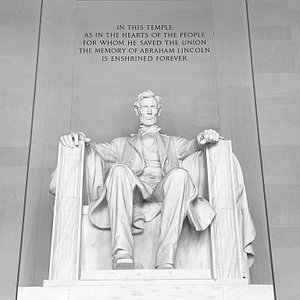
FBI Headquarters, Washington DC
- (0.16 mi) Riggs Washington DC
- (0.18 mi) Waldorf Astoria Washington DC
- (0.10 mi) Oakwood Lexington
- (0.22 mi) Kimpton Hotel Monaco Washington DC
- (0.13 mi) Capitol Corporate Housing at The Lansburgh
- (0.09 mi) Barmini
- (0.11 mi) Central Michel Richard
- (0.10 mi) Lincoln's Waffle Shop
- (0.09 mi) minibar, Washington, D.C.
- (0.10 mi) &pizza - E Street

- Visit Our Blog about Russia to know more about Russian sights, history
- Check out our Russian cities and regions guides
- Follow us on Twitter and Facebook to better understand Russia
- Info about getting Russian visa , the main airports , how to rent an apartment
- Our Expert answers your questions about Russia, some tips about sending flowers

Russian regions
- Bashkortostan republic
- Chuvashia republic
- Kirov oblast
- Mari El republic
- Mordovia republic
- Nizhegorodskaya oblast
- Orenburg oblast
- Penza oblast
- Samara oblast
- Saratov oblast
- Tatarstan republic
- Udmurt republic
- Ulyanovsk oblast
- Map of Russia
- All cities and regions
- Blog about Russia
- News from Russia
- How to get a visa
- Flights to Russia
- Russian hotels
- Renting apartments
- Russian currency
- FIFA World Cup 2018
- Submit an article
- Flowers to Russia
- Ask our Expert

Nizhny Novgorod city, Russia
The capital city of Nizhegorodskaya oblast .
Nizhny Novgorod - Overview
Nizhny Novgorod (colloquially often just “Nizhny”; from 1932 to 1990 - Gorky) is a large city located in the center of European Russia, the administrative center of the Volga Federal District and Nizhny Novgorod Oblast.
It is an important economic, industrial, scientific, educational, and cultural center of Russia, the largest transport hub of the Volga Federal District. Nizhny Novgorod is one of the main centers of river tourism in Russia. The historic part of the city is rich in sights and is a popular tourist destination.
The population of Nizhny Novgorod is about 1,234,000 (2022), the area - 411 sq. km.
The phone code - +7 831, the postal codes - 603000-603257.
Nizhny Novgorod city flag
Nizhny novgorod city coat of arms.
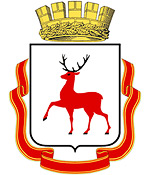
Nizhny Novgorod city map, Russia
Nizhny novgorod city latest news and posts from our blog:.
7 January, 2022 / Nikolai Bugrov's Summer Dacha in Volodarsk .
4 December, 2017 / Stadiums and Matches of the World Cup 2018 in Russia .
2 June, 2017 / The Most Beautiful House in Nizhny Novgorod .
13 March, 2016 / Official Look of Host Cities of World Cup 2018 in Russia .
29 September, 2015 / Nizhny Novgorod - the view from above .
More posts..
History of Nizhny Novgorod
Foundation of nizhny novgorod.
During the military campaigns of the Russian princes against the Volga Bulgaria, the place where the Oka River flows into the Volga was used as a gathering point for the Murom and Suzdal troops. In 1220, Grand Duke Yuri Vsevolodovich (the grandson of Prince Yuri Dolgoruky, the founder of Moscow) conducted a successful campaign against the Bulgars. After it, he “decided to strengthen this important place for Rus” and founded a town at the mouth of the Oka.
It was named Novgorod, which literally means “new town”. Later, the adjective “nizhny” (“lower”) was added to the name of the town in the Russian annals. This was probably done in order to distinguish it from the town of Novgorod (present Veliky Novgorod) and other Novgorods that existed at that time.
The founding of Nizhny Novgorod was the beginning of an active expansion of Russian influence in the Mordovian lands. Two white-stone churches were built in the fortress, including the Cathedral of the Archangel (1227) - evidence of the special role that the town had in the system of lands of Vladimir-Suzdal Rus. However, the Mongol invasion stopped further development.
Information about Nizhny Novgorod of the 13th century is extremely scarce. But it is known that after the invasion it revived relatively quickly. Nizhny Novgorod is constantly mentioned in Russian chronicles as a major political and economic center of North-Eastern Rus and a spiritual center of Orthodoxy in the Volga region. The town was often the object of conflicts between Moscow and Tver.
In 1392, the Moscow prince Vasily I received a jarlig for the Nizhny Novgorod Principality and captured Nizhny Novgorod. The final annexation of Nizhny Novgorod to the possessions of Moscow took place in the late 1440s.
More Historical Facts…
Nizhny Novgorod in the 16th-18th centuries
Under Ivan III and Vasily III, the town played the role of a border post and was a gathering place for military campaigns against the Kazan Khanate. In 1508-1515, the stone kremlin was built. After the capture of Kazan by Ivan the Terrible, the border role of Nizhny Novgorod became insignificant. At the same time, Nizhny Novgorod became the center of trade between Russia and the East and a large shipbuilding center.
In September 1611, during the Time of Troubles, the Second People’s Militia was organized in Nizhny Novgorod to fight the Poles who were able to establish control over Moscow. The militia consisted of detachments of townspeople, peasants of the central and northern regions of the Tsardom of Russia. The leaders were the Nizhny Novgorod merchant Kuzma Minin and Prince Dmitry Pozharsky (the monument to them is installed on Red Square in Moscow). In October 1612, the militia was able to completely liberate Moscow.
In the 17th century, a schism occurred in the Orthodox Church under Patriarch Nikon. It led to the formation of numerous settlements of Old Believers in the vicinity of Nizhny Novgorod. In 1695, during his Azov campaign, Peter I arrived in Nizhny Novgorod. In 1719, as a result of his administrative-territorial reforms, the town became the center of a separate Nizhny Novgorod Governorate. In 1722, setting off on the Persian campaign, Nizhny Novgorod was again visited by Peter I. Here he celebrated his 50th birthday.
In 1767, Nizhny Novgorod was visited by Empress Catherine II. During her stay in the town, she met the famous local mechanic and inventor Ivan Kulibin. After her visit, a new regular town plan was approved. The first town theater was built in 1798. Later, it became known as Nikolaevsky, in honor of Emperor Nicholas I.
Nizhny Novgorod in the 19th century
At the turn of the 18th and 19th centuries, Nizhny Novgorod became a major scientific and cultural center of the Russian Empire. In 1811, the population of Nizhny Novgorod was about 14,400 people. In 1817, the Makaryev Fair, the largest fair of the Russian Empire, was moved to the village of Kunavino (one of the districts of today’s Nizhny Novgorod). Before that, it was organized every year near the Makaryevsky Monastery, which burned down a year earlier. From that time on, it began to be called the Nizhny Novgorod Fair. Thanks to it, the rapid economic development of the town and adjacent villages began.
After Emperor Nicholas I visited the town in 1834, the large-scale reconstruction of Nizhny Novgorod began. In 1847, a water supply system appeared in the town and the first fountain was built. Private buildings in the Nizhny Novgorod Kremlin were demolished and new administrative buildings appeared in their place. A lot of new buildings, streets, boulevards, and gardens were built.
In 1849, a large industrial enterprise was founded in the village of Sormovo (another district of today’s Nizhny Novgorod). Later, it became known as the Sormovo plant. It was producing river steamers, various railway cars, steam locomotives, and trams. Thanks to the plant, Sormovo soon turned into a large village of workers. In 1862, the construction of the Moscow-Nizhny Novgorod railway was completed. In 1863, the population of the city was 41,500 people.
In 1896, the city hosted the All-Russian Trade and Industrial Exhibition. The radio receiver of the engineer A.S. Popov, the hyperboloid tower of the engineer V.G. Shukhov were demonstrated at the exhibition, as well as the first Russian car of the Frese and Yakovlev factories.
Nizhny Novgorod in the first half of the 20th century
In 1914, about 111,000 people lived in Nizhny Novgorod. In 1917, during the First World War, the Warsaw Polytechnic Institute was evacuated to this city, on the basis of which the Nizhny Novgorod Polytechnic Institute was created.
On October 7, 1932, Nizhny Novgorod was renamed Gorky due to the 40th anniversary of the literary and social activities of the writer Maxim Gorky. In 1933, the first permanent bridge across the Oka River was built. The railway bridge across the Volga was constructed too. Thanks to this, it became possible to go by rail through Gorky to the Urals and Siberia.
The 1930s were a period of rapid industrialization. In 1932, the largest industrial enterprise in the city was opened - the Gorky Automobile Plant (GAZ), an important object of the Soviet defense industry. In the 1930s-1940s, the city was even referred to as “Russian Detroit”. By 1939, the population of Nizhny Novgorod increased to about 644,000 people.
Every fourth resident of the Gorky region (about 822 thousand people) fought on the fronts of the Second World War. Of these, more than 350 thousand people did not return from the battlefields - they were killed, went missing or died from wounds in hospitals.
In June 1943, three large raids of German bombers were carried out on Gorky. The main target of air strikes was the Gorky Automobile Plant, which as a result was almost completely destroyed. It was rebuilt only in the middle of 1944. Over 500,000 wounded were treated in dozens of hospitals during the war years.
The city was an important center for the production of weapons. During the Second World War, every second Soviet car, every third tank and every fourth artillery piece were produced at Gorky’s plants. In total, about 38 thousand tanks, self-propelled guns, armored vehicles, 43 thousand mortars, 16 thousand aircraft, 22 submarines, 109 thousand cars, more than 85 thousand radio stations, as well as 101 thousand artillery pieces and 1,165 Katyusha multiple rocket launchers were produced in Gorky.
Nizhny Novgorod after the Second World War
In 1946, the first GAZ-M-20 “Pobeda” passenger car and the GAZ-51 truck left the assembly line of the Gorky Automobile Plant. In 1949, the construction of the monumental Chkalov Stairs connecting the Upper Volga and Lower Volga embankments was completed in the historic center of Nizhny Novgorod. On August 4, 1959, the resolution of the Council of Ministers of the USSR “On the closure of the city of Gorky for visiting by foreigners” was issued. In 1962, the population of Gorky exceeded 1 million people.
On January 18, 1970, a radiation accident occurred at the Krasnoe Sormovo plant. During the construction of a nuclear submarine, an unauthorized launch of the reactor took place. After working at prohibitive power for about 10-15 seconds, it partially collapsed. Hundreds of workers were exposed to the radioactive release. In total, over one thousand people took part in the liquidation of the consequences of the accident and were exposed to radiation.
In 1985, a subway was opened in Gorky. In 1980-1986, Andrei Sakharov, a world famous nuclear physicist, Nobel laureate, and activist, was in exile in Gorky to prevent his contacts with foreigners. In the early 1990s, the “closed city” status was lifted and the city became accessible to foreigners. On October 22, 1990, Gorky was renamed back to Nizhny Novgorod. In 1991, the population of the city reached its maximum - 1,445,000 people.
At the end of the 20th century, the information technology sphere began to actively develop in the city. In the 2000s, a transport problem arose because of the insufficient carrying capacity of the Nizhny Novgorod bridges connecting the lower part of the city and the upper one.
In February 2012, the Nizhny Novgorod Volga Aerial Tramway was opened. This 3661-meter-long gondola lift cable car connected Nizhny Novgorod with the town of Bor. Its daily passenger traffic is about 5,000 people. In 2013, the city electric train was launched - an alternative to the subway line from Sormovo to Moskovsky railway station.
Nizhny Novgorod hosted 6 matches of the FIFA World Cup 2018 . A new stadium was built, the old river port was demolished, a new park and embankments were created. Large-scale restoration of old streets and buildings took place, new museums were opened, hotels were built, and parks were reconstructed.
Streets of Nizhny Novgorod
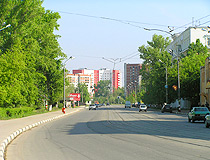
One sunny summer day in Nizhniy Novgorod
Author: Denis Plekhanov
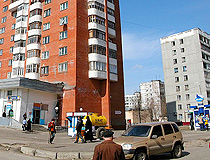
Apartment buildings in Nizhny Novgorod
Author: Eugene Ivanov
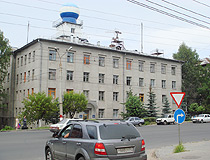
On the street in Nizhny Novgorod
Author: Sergey S. Kazenyuk
Nizhny Novgorod - Features
Nizhny Novgorod is located about 425 km east of Moscow, at the confluence of the two largest waterways of the European part of Russia - the Volga and Oka rivers. The city is divided by the Oka into two parts. The length of Nizhny Novgorod along the Oka is 20 km, along the Volga - about 30 km.
The climate in Nizhny Novgorod is moderately continental, with cold, long winters and warm, relatively short summers. The average temperature in January is minus 8.9 degrees Celsius, in July - plus 19.4 degrees Celsius.
A red deer is depicted on the coat of arms and flag of Nizhny Novgorod, which is a symbol of nobility, purity, life, wisdom, and justice. The City Day is celebrated on the 3rd Saturday in August.
In January 2019, Nizhny Novgorod was recognized as the best city in Russia in terms of quality of life. It took first place among Russian cities and 109th in the world in terms of quality of life. The rating was compiled by the site numbeo.com, which specializes in statistics on the cost of living and consumer prices in different countries of the world.
When compiling the rating, the purchasing power of the population, safety, health care, the cost of living, the ratio of real estate prices to the population’s income, traffic congestion, the level of environmental pollution, and climate were taken into account.
The main branches of the local industry are the production of cars and weapons, shipbuilding. Nizhny Novgorod is also one of the IT centers of Russia.
Nizhny Novgorod is a major transport hub. The city has a railway station, a river station, a cargo port, several berths for transshipment of goods. Strigino International Airport named after V.P. Chkalov offers regular flights to such cities as Yekaterinburg, Kazan, Kaliningrad, Moscow, Novosibirsk, Samara, St. Petersburg, Sochi, and a number of others.
Public transport in Nizhny Novgorod plays a very important role in ensuring the life of the city. At the same time, its work is hampered by the distribution of its population on the city’s territory, large daily migrations, a very high concentration of passenger traffic on the bridges across the Oka River, and the lack of an all-encompassing system of high-speed transport. There are municipal buses, fixed-route minibuses, trams, trolleybuses, the city train, and subway.
The tourist potential of Nizhny Novgorod is quite high. According to UNESCO, it is one of the most valuable historical cities in the world. In total, there are more than 600 unique historical, architectural and cultural monuments in Nizhny Novgorod, a variety of museums. The best time to visit Nizhny Novgorod is summer.
One of the alternative ways to visit Nizhny Novgorod is to take a river cruise along the Volga River. Travelers will find exciting excursions and meals in traditional Russian taverns. It will also be interesting to come during one of the many fairs or ethnographic festivals that are held in the city.
Main Attractions of Nizhny Novgorod
Nizhny Novgorod Kremlin (1508-1515) - a fortress in the historic center of Nizhny Novgorod and its oldest part, the main architectural complex of the city located on the right high bank, at the confluence of the Volga and Oka rivers. To date, all 13 towers of the Nizhny Novgorod Kremlin have been preserved or have been restored. The thickness of the wall at the base reaches 5 meters. There are exhibitions in the towers of the fortress; a section of the wall is open for tourists to visit.
In the past, there were several churches on the territory of the Nizhny Novgorod Kremlin. Today, only the Archangel Michael Cathedral has survived, built no later than the middle of the 16th century and rebuilt in 1628-1631 - the oldest surviving building in the kremlin. There is the grave of Kuzma Minin inside it.
An excellent view of the Volga River and Strelka (the confluence of the Oka and Volga) opens from the walls of the Nizhny Novgorod Kremlin. Here you can also see a collection of military equipment from the Second World War.
Nizhny Novgorod State Art Museum - one of the oldest museums in Russia, the largest museum of fine arts in the Nizhny Novgorod region. The Governor’s Palace on the territory of the Nizhny Novgorod Kremlin houses a permanent exhibition of Russian art and a collection of artistic silver.
In the House of the Merchant and Benefactor D.V. Sirotkin (Verkhnevolzhskaya Embankment, 3), an exposition of Western European art is presented and, separately, the painting by K.E. Makovsky “The appeal of Kuzma Minin to the citizens of Nizhny Novgorod” - one of the largest paintings on a historical theme in Russia (698x594 cm).
Chkalov Stairs (1943-1949) - a monumental staircase in the form of a figure eight in the historic center of Nizhny Novgorod. Connecting the Upper Volga (Verkhnevolzhskaya) and Lower Volga (Nizhnevolzhskaya) embankments, it is one of the longest stairs in Russia. It starts from the observation deck at the monument to Valery Chkalov (the famous Soviet pilot who made the first non-stop flight from the USSR to the USA via the North Pole), next to the St. George Tower of the Nizhny Novgorod Kremlin.
Bolshaya Pokrovskaya Street - the main street of Nizhny Novgorod built up with noble mansions of the past centuries. A large part of Bolshaya Pokrovskaya is reserved for the pedestrian zone and is analogous to the pedestrian Arbat Street in Moscow. There are a lot of historic houses, cafes, souvenir shops, boutiques, monuments, and sculptures here. The length of the street is over 2 km.
The building of the State Bank (Bolshaya Pokrovskaya Street, 26), resembling a medieval palace, is an outstanding architectural monument built in the Russian Revival style in 1911-1913. In the Museum of Old Equipment and Tools (Bolshaya Pokrovskaya Street, 43), you can see unique exhibits, hear their history, and even touch them.
Fedorovsky Embankment - one of the most beautiful embankments in Nizhny Novgorod and the best observation deck in the city. Everything is perfectly visible from this embankment: the old part of the city, the river station with a park, the Kanavinsky bridge - one of the oldest in the city, and, of course, the opposite bank of the Oka River with the Alexander Nevsky Cathedral, the confluence of the Oka and Volga. People also come here to watch the sunset.
Nizhny Novgorod Volga Aerial Tramway . This cable car, 3661 meters long, connects the high right bank of the Volga River, where the historic part of Nizhny Novgorod is located, with the town of Bor. It has the largest unsupported span over the water surface in Europe - 861 meters.
A one way trip during which you can admire the picturesque views of Nizhny Novgorod and the Volga River takes 15 minutes. It is better to use it in good sunny weather, because in windy weather, the movement of the cabins can be stopped. Sennaya Square on Kazanskaya Embankment.
Nizhny Novgorod State Museum of History and Architecture (1875-1877). Also known as the Mansion of S.M. Rukavishnikov, it is an architectural ensemble built in the eclectic style in the historic center of Nizhny Novgorod, one of the most important and famous architectural monuments of this city. Guided tours are held in the premises, allowing you to learn about the life of the former owners of the mansion, as well as look at the historical expositions of different years. Verkhnevolzhskaya Embankment, 7.
Main Palace of Nizhny Novgorod Fair - a luxurious building constructed in the forms of Old Russian architecture of the 17th century. Today, exhibitions of various formats are held here, as well as the multimedia exposition “Russia - my history” dedicated mainly to the history of Nizhny Novgorod starting from the Finno-Ugric peoples. Sovnarkomovskaya Street, 13.
Museum of the History of the Gorky Automobile Plant . The museum houses expositions telling about the history and development of the Gorky Automobile Plant. In total, there are over 40,000 exhibits. Here you can see a collection of Soviet vintage cars, which includes “Chaika”, “Volga”, the truck “GAZ-51”, and a lot of others. Lenina Avenue, 95.
Alexander Nevsky Cathedral (1868-1881) - the most noticeable sight of the lower part of Nizhny Novgorod, which can be seen from all observation decks of the upper city. The church, 87 meters high, was built on the site of the Nizhny Novgorod Fair at the expense of merchants, who wanted to perpetuate the visit of Emperor Alexander II. Strelka Street, 3a.
Church of the Nativity of the Blessed Virgin Mary (1696-1719) - one of the best examples of the Stroganov Baroque, an architectural monument of federal significance. From a distance, this colorful building looks like a sugar gingerbread with “candy” domes and decorated with stone flowers, pears and apples. Rozhdestvenskaya Street, 34.
Pechersky Ascension Monastery - one of the most interesting places in Nizhny Novgorod, where you can feel the spirit of the city. Most of the monastery buildings date back to the first half of the 17th century. A lot of beautiful photographs can be taken here. Privolzhskaya Sloboda Street, 108.
Limpopo Zoo - the first private zoo in Russia. More than 270 species of animals live here, 25 of which are listed in the Red Book of the Russian Federation. It is located on the territory of the Sormovsky Park on an area of 7.1 hectares. Yaroshenko Street, 7b.
Architectural and Ethnographic Museum-Reserve “Shcholokovskiy Khutor” . The exposition of this museum is represented by 16 objects of rural architecture: residential houses, barns, mills and churches of the 17th-19th centuries brought from the northern districts of the Nizhny Novgorod region. The facades of the houses are decorated with traditional relief carvings. In the premises of the houses, interiors with authentic items of peasant life have been restored. Gorbatovskaya Street, 41.
Nizhny Novgorod city of Russia photos
Pictures of nizhny novgorod.
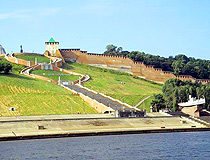
Chkalov Stairs and the Nizhny Novgorod Kremlin
Author: Sergey Bulanov
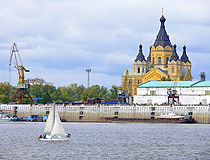
Alexander Nevsky Cathedral in Nizhny Novgorod
Author: Evgeniy Balashov
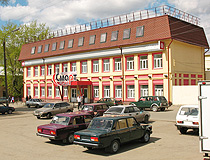
Shopping and office center Smart in Nizhny Novgorod
Author: Diman Lazarev
Sights of Nizhny Novgorod
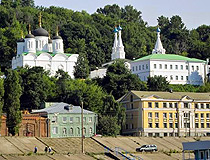
Annunciation Monastery - the oldest monastery in Nizhny Novgorod
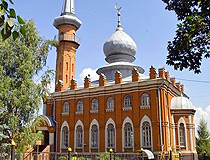
Nizhny Novgorod Cathedral Mosque
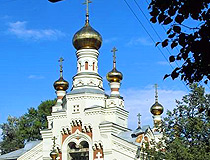
Church in honor of the icon of the Mother of God Joy of All Who Sorrow in Nizhny Novgorod
The comments of our visitors
- Currently 3.14/5
Rating: 3.1 /5 (250 votes cast)
Cities [ edit ]

- 56.326944 44.0075 1 Nizhny Novgorod — Russia's fourth largest city, the regional capital, located at the confluence of the Volga and Oka Rivers, and the hub for the Volga Region ; be sure to visit the kremlin and the Sakharov Museum
- Arzamas — the region's third largest city is most notable for its grandiose Resurrection Cathedral, built to commemorate Russia's victory over Napoleon in 1812
- Balakhna — a small historic city with several noteworthy architectural monuments, including the 16th century Saint Nicholas Church
- Bogorodsk — a small town with a pretty, well-preserved central square and cathedral, as well as several 19th century estates outside the town that have been converted into parks
- Bolshoye Boldino (Veliko Boldino) — a historic village that served as the estate of one very famous A.S. Pushkin; the village now has several worthwhile museums dedicated to the poet and hosts the All-Russia Poetry Prize Festival each year on the first Sunday of June
- Bor — you can see this city while looking across the Volga from Nizhny Novgorod's downtown. Center of ship-building and glass-making industry
- Dzerzhinsk — the region's second largest city is one of the world's most polluted, due to its history as a major chemicals production site, and has life expectancies of less than 50 years for both men and women; the city was until 1990 closed to foreigners, but is now open for those who wish to see its singular and towering hyperboloid Shukhov Tower on the banks of the Oka River
- Kstovo — a small Soviet-era industrial city (petrochemicals), which grew out of on an old village of the same name. Kstovo is home to the World Sambo Academy; an important 18th-century church is in the adjacent village of Veliky Vrag
- 56.650278 43.470278 2 Gorodets — an historic town, founded by Prine Yuriy Dolgorukiy in 1152, which lost a number of churches to atheistic campaigns under the USSR, but retains some wonderful fairytale-like wooden houses.
- Sarov — a small closed city, formerly a secret city known as Arzamas-16, which serves as a major center for Russia (and the USSR's) nuclear program, has rather European architecture since it was built by German POWs, and is located near the holy Sarova monastery; in reference to the US nuclear program at Los Alamos , researchers here fondly call the city "Los Arzamas"
Other destinations [ edit ]
- Kerzhensky Nature Reserve
- Makaryevsky Monastery — a huge and beautiful monastery on the Volga River, which is easily reached by a summer 3 hour long hydrofoil from Nizhny Novgorod
Understand [ edit ]
Nizhny Novgorod Oblast is one of the most populous and economically important regions of the Volga Region, centered on its capital Nizhny Novgorod. Aside from the capital itself, the region is perhaps best known outside of Russia for its tradition of making painted, wooden matryoshka dolls. Less known, perhaps, are Khokhloma handicraft.
Talk [ edit ]
See Russian phrasebook .
Get in [ edit ]

By train [ edit ]
The city of Nizhny Novgorod is one of the first major stops from Moscow on one of the main routes of the Trans-Siberian Railway (8 hour trip). Several trains form Moscow terminate in Nizhny Novgorod (two overnight trains and one or two faster day trains). Many others continue beyond, to Kirov , Perm , Yekaterinburg , and points east, up to Vladivostok and Beijing . Some of these trains also stop at a number of other stations as they cross the oblast, e.g. Dzerzhinsk before reaching the Nizhny, or Semenov , Shakhunya and Uren beyond it. These trains usually leave from Moscow's Kursk Station or Yaroslavl Station .
Several faster trains ( Lastochka and Strizh ) make the trip between Moscow and Nizhny Novgorod in about 4 hours.
There is also a direct daily train to Nizhny Novgorod from Saint Petersburg , and, at least during the summer seasons, from a number of destinations on the Black Sea coast, such as Adler (for Sochi ). Trains from Nizhny Novgorod also travel south, to/from Saransk ( Mordovia ) and Kazan (via the Kanash junction in Chuvashia .
Some cities in southern part of the oblast ( Navashino , Arzamas , Sergach ) are easily reachable by trains running on another route ( Moscow - Kazan ) of the Trans-Siberian system. They leave from Moscow's Kazan Station .
By plane [ edit ]
Nizhny Novgorod's Strigino airport (GOI) had a new terminal opened in 2016, just when most of direct international flights to Nizhny Novgorod (Lufthansa from Frankfurt , Finnair from Helsinki , or Czech from Prague ) were terminated. The city is still served by inexpensive domestic flights from major Russian cities—the flight from Moscow is as cheap as $35. Kaliningrad based KD Avia offers flights to Kaliningrad and then on to a number of Russian and international destinations. There are also direct flights to a number of destination in Central Asia (popular with migrant workers), and (mostly charter or seasonal) flights to some Mediterranean tourist destinations.
The airport is served by several city bus lines (in daytime only). One can take any of these buses to get to the nearest subway lines, and then take subway to wherever it goes.
By boat [ edit ]
Nizhny Novgorod is frequently included as a stop on summer boat cruises on the Volga River; some boats also stop at the Makariev Monastery.
By bus [ edit ]
A fair number of intercity buses circulate along the Volga Highway (aka M7), between Moscow, Nizhny Novgorod, Cheboksary, and Kazan. While less convenient than trains, buses allow access to towns not served by rail, such as Lyskovo.
Bus [ edit ]
There is no rail line due east of Nizhny Novgorod. Instead, one can take a bus along the M7 highway (the Kazan highway). Commuter buses for Kstovo and other destinations nearby go from the Sennaya bus station a few blocks east of Sennaya Square; to go further east, take a bus from the Main Bus Station ( Avtovokzal ) near Lyadov Square.
One can also take a bus from the Main Bus Station to various points throughout the southern half of the oblast, e.g. Arzamas.
Buses to the west (toward Moscow), northwest (Chkalovsk), and north (Bor) run mostly from a bus station near Nizhny Novgorod's Moscow Station.
Boat [ edit ]
In the summer, hydrofoil boats (colloquially known as Raketa , after the first model of them) used to run from Nizhny Novgorod's River Terminal ( Rechnoy Vokzal ) down the Volga, to Rabotki , Makaryevo , and beyond. Unfortunately, by 2010, most of these services have been cancelled.
Ferryboats from downtown Nizhny Novgorod run to Bor across the river (very frequent service). There is also much less frequent service (half a dozen trips a day) between Lyskovo and Marakyevo, providing easy access to Makaryev Monastery. Both systems transport passengers and vehicles.
Aerial ropeway [ edit ]

A unique installation for central Russia, an aerial ropeway spans the Volga, connecting Nizhny Novgorod with Bor. The scenic service is very frequent, although somewhat pricey for such a short distance (90 RUR, as of 2016).
See [ edit ]
Outside of the cities, there are a number of important monasteries within Nizhny Novgorod Oblast, such as Makaryev Monastery (across the Volga from Lyskovo), or the Diveyevo Monastry not far from Sarov, in the southwest of the province.
Do [ edit ]
Eat [ edit ], drink [ edit ], stay safe [ edit ], go next [ edit ].
Russia's Golden Ring is nearby and its prominent attractions at Vladimir and Suzdal can be daytripped from Nizhny Novgorod by bus.
The next major stops on the Trans-Siberian Railway are Vladimir to the west and Kirov to the east.
- Has custom banner
- Has mapframe
- Has map markers
- City listing with no coordinates
- Outline regions
- Outline articles
- Region articles
- Bottom-level regions
- Has Geo parameter
- Volga Region
- All destination articles
- Pages with maps
Navigation menu

An official website of the United States government
Here’s how you know
Official websites use .gov A .gov website belongs to an official government organization in the United States.
Secure .gov websites use HTTPS A lock ( ) or https:// means you’ve safely connected to the .gov website. Share sensitive information only on official, secure websites.

- Explore sell to government
- Ways you can sell to government
- How to access contract opportunities
- Conduct market research
- Register your business
- Certify as a small business
- Become a schedule holder
- Market your business
- Research active solicitations
- Respond to a solicitation
- What to expect during the award process
- Comply with contractual requirements
- Handle contract modifications
- Monitor past performance evaluations
- Explore real estate
- 3D-4D building information modeling
- Art in architecture | Fine arts
- Computer-aided design standards
- Commissioning
- Design excellence
- Engineering
- Project management information system
- Spatial data management
- Facilities operations
- Smart buildings
- Tenant services
- Utility services
- Water quality management
- Explore historic buildings
- Heritage tourism
- Historic preservation policy, tools and resources
- Historic building stewardship
- Videos, pictures, posters and more
- NEPA implementation
- Courthouse program
- Land ports of entry
- Prospectus library
- Regional buildings
- Renting property
- Visiting public buildings
- Real property disposal
- Reimbursable services (RWA)
- Rental policy and procedures
- Site selection and relocation
- For businesses seeking opportunities
- For federal customers
- For workers in federal buildings
- Explore policy and regulations
- Acquisition management policy
- Aviation management policy
- Information technology policy
- Real property management policy
- Relocation management policy
- Travel management policy
- Vehicle management policy
- Federal acquisition regulations
- Federal management regulations
- Federal travel regulations
- GSA acquisition manual
- Managing the federal rulemaking process
- Explore small business
- Explore business models
- Research the federal market
- Forecast of contracting opportunities
- Events and contacts
- Explore travel
- Per diem rates
- Transportation (airfare rates, POV rates, etc.)
- State tax exemption
- Travel charge card
- Conferences and meetings
- E-gov travel service (ETS)
- Travel category schedule
- Federal travel regulation
- Travel policy
- Explore technology
- Cloud computing services
- Cybersecurity products and services
- Data center services
- Hardware products and services
- Professional IT services
- Software products and services
- Telecommunications and network services
- Work with small businesses
- Governmentwide acquisition contracts
- MAS information technology
- Software purchase agreements
- Cybersecurity
- Digital strategy
- Emerging citizen technology
- Federal identity, credentials, and access management
- Mobile government
- Technology modernization fund
- Explore about us
- Annual reports
- Mission and strategic goals
- Role in presidential transitions
- Get an internship
- Launch your career
- Elevate your professional career
- Discover special hiring paths
- Events and training
- Agency blog
- Congressional testimony
- GSA does that podcast
- News releases
- Leadership directory
- Staff directory
- Office of the administrator
- Federal Acquisition Service
- Public Buildings Service
- Staff offices
- Board of Contract Appeals
- Office of Inspector General
- Region 1 | New England
- Region 2 | Northeast and Caribbean
- Region 3 | Mid-Atlantic
- Region 4 | Southeast Sunbelt
- Region 5 | Great Lakes
- Region 6 | Heartland
- Region 7 | Greater Southwest
- Region 8 | Rocky Mountain
- Region 9 | Pacific Rim
- Region 10 | Northwest/Arctic
- Region 11 | National Capital Region
- Per Diem Lookup
About the J. Edgar Hoover FBI Building
Founded in 1908, the Federal Bureau of Investigation (FBI) was originally housed within the Department of Justice headquarters building. For its first 67 years the bureau hobbled together space within various Department of Justice buildings, including the Old Post Office. By the mid-twentieth century, the Bureau’s rapidly growing body of agents, specialists and staff were a highly visible national force. Construction of a purpose-built headquarters building finally began in the early 1960s, but was halted due to further necessary planning and design reviews. In 1977, the Brutalist style building, today named in honor of the longest serving FBI director, J. Edgar Hoover, was finally complete.
PER DIEM LOOK-UP
1 choose a location.
Error, The Per Diem API is not responding. Please try again later.
No results could be found for the location you've entered.
Rates for Alaska, Hawaii, U.S. Territories and Possessions are set by the Department of Defense .
Rates for foreign countries are set by the State Department .
2 Choose a date
Rates are available between 10/1/2021 and 09/30/2024.
The End Date of your trip can not occur before the Start Date.
Traveler reimbursement is based on the location of the work activities and not the accommodations, unless lodging is not available at the work activity, then the agency may authorize the rate where lodging is obtained.
Unless otherwise specified, the per diem locality is defined as "all locations within, or entirely surrounded by, the corporate limits of the key city, including independent entities located within those boundaries."
Per diem localities with county definitions shall include "all locations within, or entirely surrounded by, the corporate limits of the key city as well as the boundaries of the listed counties, including independent entities located within the boundaries of the key city and the listed counties (unless otherwise listed separately)."
When a military installation or Government - related facility(whether or not specifically named) is located partially within more than one city or county boundary, the applicable per diem rate for the entire installation or facility is the higher of the rates which apply to the cities and / or counties, even though part(s) of such activities may be located outside the defined per diem locality.

IMAGES
VIDEO
COMMENTS
More on the FBI Building and Tour. The tour of the FBI is actually one of the oldest ones around. It started in 1937, when headquarters was in the Department of Justice building. In 1975, the FBI moved to its current location, the J. Edgar Hoover Building, on Pennsylvania Avenue NW. After Sept. 11, the tour closed for security reasons.
The J. Edgar Hoover FBI Headquarters. The FBI moved into this building in 1975 from the Department of Justice building across the street. It was immediately criticized and remains unloved by most to this day. In fact, the FBI will be moving soon - the building has reached the end of its lifespan.
October 31, 2023 Washington DC, Activities. I've always been fascinated by the inner workings of the FBI. So when I learned that they offer public tours of the J. Edgar Hoover Building in Washington DC, their headquarters, I knew I had to find a way to visit. Planning a trip to DC can be a bit of a juggling act.
Thus, work on the J. Edgar Hoover Building began. The building opened its doors in 1975 and serves the American people to this day. Experience the FBI. The FBI Experience is a self-guided tour at FBI Headquarters in Washington, D.C. Open to the public, the tour features interactive multimedia exhibits, content, and artifacts—including a ...
The J. Edgar Hoover Building is a low-rise office building located at 935 Pennsylvania Avenue NW in Washington, D.C., in the United States.It is the headquarters of the Federal Bureau of Investigation (FBI).. Planning for the building began in 1962, and a site was formally selected in January 1963. Design work, focusing on avoiding the blocky, monolithic structure typical of most federal ...
In 1975, the J. Edgar Hoover building was opened to house Headquarters and the tour became a significant component of the new building. Following the events of September 11, 2001, the tour was closed due to security risks, as well as associated costs, and has remained so for nearly 10 years.
About the J. Edgar Hoover FBI Building. Founded in 1908, the Federal Bureau of Investigation (FBI) was originally housed within the Department of Justice headquarters building. For its first 67 years the bureau hobbled together space within various Department of Justice buildings, including the Old Post Office. By the mid-twentieth century, the ...
The best J. Edgar Hoover Building Tours are: Washington DC: See the City Segway Tour. Washington DC Must See Sights Half-Day Tour. From NYC: Niagara Falls, Washington, and Philadelphia Tour. Washington DC: Private Tour with Luxury Vehicle. Washington, DC: Lincoln Assassination Self-Guided Audio Tour.
J. Edgar Hoover Building: Our most recommended tours and activities. 1. Washington DC Must See Sights Half-Day Tour. Washington D.C. showcases some of the most majestic monuments and memorials in America. With so much to see this sightseeing bus tour makes for a great orientation option, especially for those with little time.
Attractions around J. Edgar Hoover FBI Building The Evening Star Building. Listed as a National Historic Landmark and located directly across Pennsylvania Avenue from the Old Post Office, the Evening Star Building's Beaux-Arts façade is decorated with intricate hand-carved marble scrollwork and ornamental friezes. Built in 1898, it is the last ...
J. Edgar Hoover Building: Our most recommended tours and activities. 1. Washington DC: See the City Segway Tour. Arrive 30 minutes before the tour time for instruction on how to ride a Segway, then head off on a thrilling guided Segway tour of Washington DC and its main landmarks. Listen as your guide recounts fascinating stories about these ...
The J. Edgar Hoover Federal Building was the first purpose-built headquarters of the FBI, the federal government's chief investigative law enforcement agency. The FBI was founded in 1908 to address a perennial lack of detective personnel in the federal government. The late 1950s and early 1960s represented a pinnacle of the Bureau's power ...
The Federal Bureau of Investigation offers a tour of its headquarters at the J. Edgar Hoover building in Washington, DC. Tours are available Monday through Friday between 9:00 AM and 3:00 PM. They last approximately 90 minutes and must be requested through a Member of Congress. The tour features content, objects, and interactive multimedia ...
This tour is located at the J. Edgar Hoover building in Washington, D.C. and is available Monday through Friday between 9:00 a.m. and 1:00 p.m. for groups of 10 or less. Tours lasts approximately 90 minutes and must be requested through a Member of Congress.
For several years, the Federal Bureau of Investigation (FBI) has planned to leave its headquarters in the J. Edgar Hoover Building on Washington, D.C.'s Pennsylvania Ave. and move to a to-be-determined suburban location.But no more. On Tuesday, the U.S. General Services Adminstration (GSA) and FBI announced that they are dropping plans to find a new home for the FBI due to a "$882 million ...
On May 10, 1924, one of the worst events in history for American civil liberties happened: 29-year-old J. Edgar Hoover assumed the role of director of the then-Bureau of Investigation. Ambitious ...
The historic part of the city is rich in sights and is a popular tourist destination. The population of Nizhny Novgorod is about 1,234,000 (2022), the area - 411 sq. km. The phone code - +7 831, the postal codes - 603000-603257. Local time in Nizhny Novgorod city is April 28, 6:20 am (+3 UTC).
Nizhny Novgorod is the administrative centre of Nizhny Novgorod Oblast and the Volga Federal District in Russia. The city is located at the confluence of the Oka and the Volga rivers in Central Russia, with a population of over 1.2 million residents, up to roughly 1.7 million residents in the urban agglomeration. Nizhny Novgorod is the sixth-largest city in Russia, the second-most populous ...
Understand. Nizhny Novgorod Oblast is one of the most populous and economically important regions of the Volga Region, centered on its capital Nizhny Novgorod. Aside from the capital itself, the region is perhaps best known outside of Russia for its tradition of making painted, wooden matryoshka dolls. Less known, perhaps, are Khokhloma handicraft.
Learn more about GSA's extensive portfolio and leadership in sustainability and preserving historic buildings by exploring the buildings in the NCR.
Nizhny Novgorod Oblast is a region in the Upper Volga, bordering Ryazan Oblast to the southwest, Vladimir Oblast to the west, Ivanovo Oblast to the northwest, Kostroma Oblast to the north, Kirov Oblast to the northeast, Mari El to the east, Chuvashia to the southeast, and Mordovia to the south. Photo: Кривошеина Мария, CC BY-SA 4.0.